The Colonial Era in India Chapter Notes | Chapter Notes For Class 8 PDF Download
Introduction
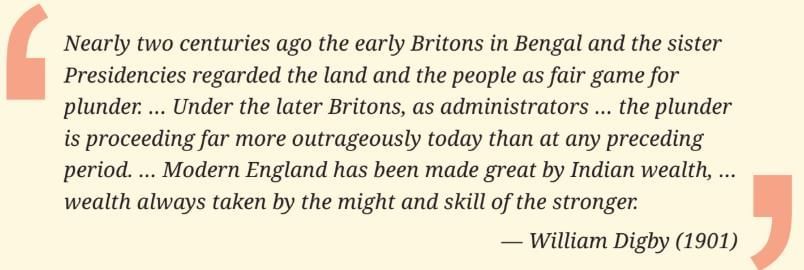
The Colonial Era in India was a time when European powers, like the Portuguese, Dutch, French, and British, came to India, first as traders and later as rulers, changing the country’s history. Their arrival brought new trade, ideas, and conflicts, but also led to the exploitation of India’s wealth and people. This chapter explores how these foreigners shaped India’s economy, society, and culture, and how Indians fought back against their rule.
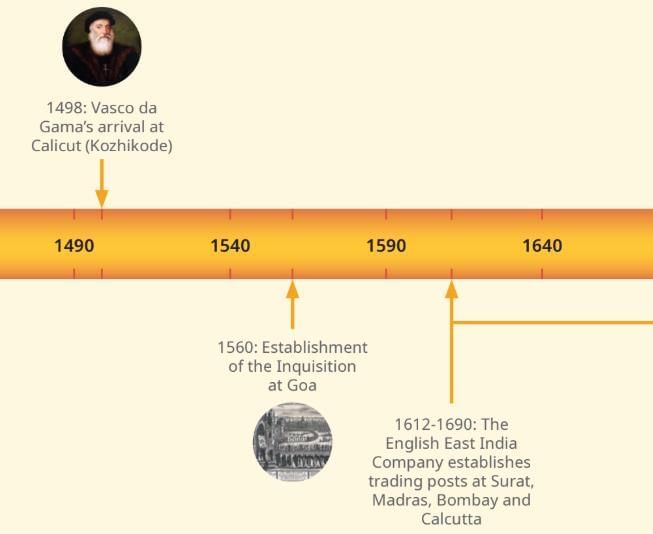
The Age of Colonialism
Colonialism began when powerful nations took over weaker regions to gain wealth, power, and influence, often at the expense of native people and their traditions.
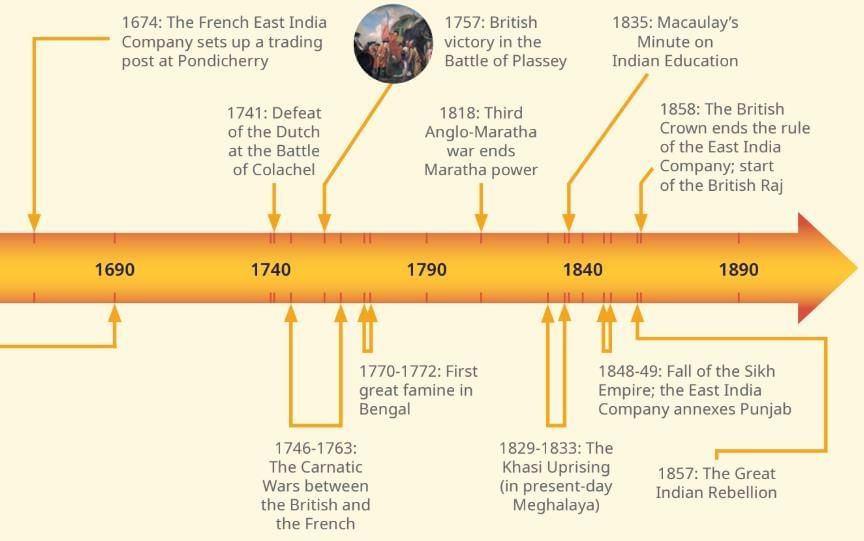
What is Colonialism?
- Colonialism is when one country takes control of another region, setting up settlements and imposing its own political, economic, and cultural systems.
- It began long ago with ancient empires in the 1st millennium BCE and continued with the spread of Christianity and Islam in the 1st millennium CE, which involved colonising new territories.
European Expansion
- The “Age of Colonialism” refers to Europe’s expansion starting in the 15th century, when countries like Spain, Portugal, Britain, France, and the Netherlands built colonies in Africa, Asia, the Americas, Australia, and Pacific islands.
- They conquered these regions through military campaigns, often massacring or enslaving native people.
Reasons for Colonialism
- European powers competed for global influence, racing to control more land for political power.
- Colonies gave access to new resources, markets, and trade routes, often through plundering local wealth.
- Converting people to Christianity was a major goal, along with exploring unknown lands to learn about geography and nature.
Impact on Colonised Regions
- Colonisers claimed they brought “progress” with a “civilising mission,” but often called native people “savage” or “primitive.”
- In reality, colonised regions lost independence, had their resources exploited, traditional ways of life destroyed, and faced foreign cultural values.
- While the colonial era connected the world and grew economies and technology, the benefits went mostly to the colonisers, leaving colonised people with immense hardships.
Resistance and Decline
- Many colonised regions resisted foreign rule, and colonialism declined in the mid-20th century, especially after World War II, when most colonies gained independence.
- This chapter focuses on India’s experience with European colonialism and its impact.
Europeans in India
Drawn by India’s wealth and trade, European nations like the Portuguese, Dutch, and French established trading posts, which later became bases for colonial control.
India’s Pre-Colonial Prosperity
- India traded with Greeks and Romans over 2,000 years ago, exporting spices, cotton, ivory, gems, sandalwood, teakwood, and wootz steel, highly valued in the Mediterranean.
- Until the 16th century, India was a major economic and cultural power, contributing about one-fourth of the world’s GDP, alongside China, as estimated by economist Angus Maddison.
- European travellers from the 16th century described India as “flourishing,” noting its strong manufacturing, diverse agriculture, and widespread trade networks.
- India’s wealth made it a tempting target for European colonial powers.
The Portuguese: Commerce and Atrocities
- Vasco da Gama arrived in Kappad, near Kozhikode (Kerala), in 1498, marking the start of European colonisation in India.
- Though initially welcomed, his aggressive actions, like seizing, torturing, and killing Indian merchants and bombarding Calicut during his second voyage, strained relations with local rulers.
- The Portuguese captured key ports, including Goa in 1510, which became their colonial capital, and set up trading posts along the Malabar and Coromandel coasts.
- They enforced a cartaz (pass) system, requiring ships in the Arabian Sea to buy Portuguese permits, seizing those without permits to control the spice trade for nearly a century.
- In Goa, the Portuguese set up the Inquisition in 1560, persecuting Hindus, Muslims, Jews, and Christian converts suspected of following their original faiths, forcing conversions and destroying Hindu temples, with the Inquisition lasting until 1812.
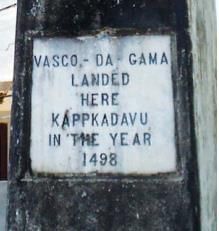
The Fierce Queens of Ullal
Rani Abbakka I
- Ruled the strategic port town of Ullal in present-day southern Karnataka during the 16th century.
- Successfully resisted multiple Portuguese attempts to take control of the region.
- Formed alliances with neighbouring kingdoms to strengthen her resistance.
- Eventually captured and died fighting in prison.
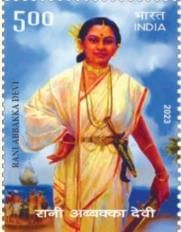 Post Stamp
Post Stamp
Rani Abbakka II
- Took up the mantle after Rani Abbakka I.
- Reportedly used fireballs made from coconut shells to set Portuguese ships on fire.
- Their legacy lives on through Yakshagana, a traditional dance-drama that commemorates their bravery.
The Dutch: Commerce and Competition
- The Dutch arrived in the early 17th century, focusing on trade, especially spices, through their Dutch East India Company.
- They set up trading posts in Surat, Bharuch, and Cochin on the west coast, and Nagapattinam and Masulipatnam (now Machilipatnam) on the east coast, with a strong presence in Kerala’s Malabar region, where they displaced the Portuguese.
- Their influence declined after losing the Battle of Colachel in 1741 to Travancore’s forces under King Marthanda Varma, a rare victory of an Asian power over a European one, weakening Dutch control in India.
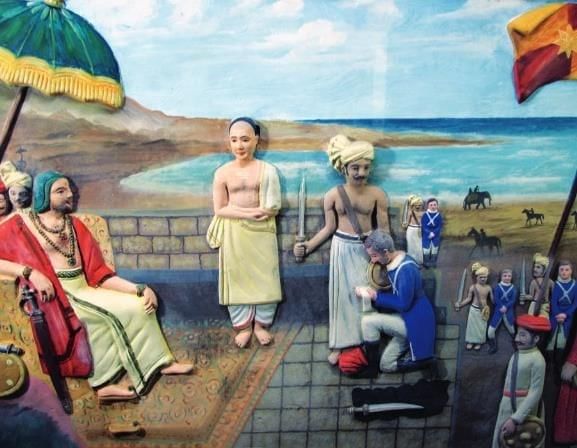 A depiction of the surrender of Dutch forces to King Marthanda Varma
A depiction of the surrender of Dutch forces to King Marthanda Varma
The French: Colonial Ambitions
- The French arrived later, establishing a trading post in Surat in 1668 and Pondicherry (now Puducherry) in 1674, where their East India Company planned a French empire in India.
- Governor-General Dupleix (1742–1754) trained Indian soldiers (sepoys) in European military tactics and used indirect rule by installing puppet Indian rulers through local disputes.
- The French faced the British in the Carnatic Wars (1746–1763), capturing Madras in 1746 but losing ground, with their colony reduced to Pondicherry and a few small enclaves.
- Unlike the Portuguese, the French rarely interfered in Indian social or religious life, but in 1748, Dupleix, influenced by Jesuit priests and his wife, ordered the destruction of Pondicherry’s Vedapurishwaran temple to promote Christianity.
- Overall, the French focused on modest trade rather than large-scale control.
Enter the British
The British East India Company, starting as traders, used clever strategies to become rulers, dominating India for nearly two centuries.
From Traders to Rulers
- The British ruled India for nearly two centuries through the English East India Company, which started as a trading group but became an imperial power.
- Established with a royal charter from Queen Elizabeth I, the Company had special powers, like raising a private army, but initially acted as traders to avoid suspicion.
- In the 17th century, they set up trading posts in Surat, Madras, Bombay, and Calcutta with little resistance, as local rulers welcomed foreign trade, a common practice in India.
- These small trading posts hid the Company’s bigger plan to gain control over India.
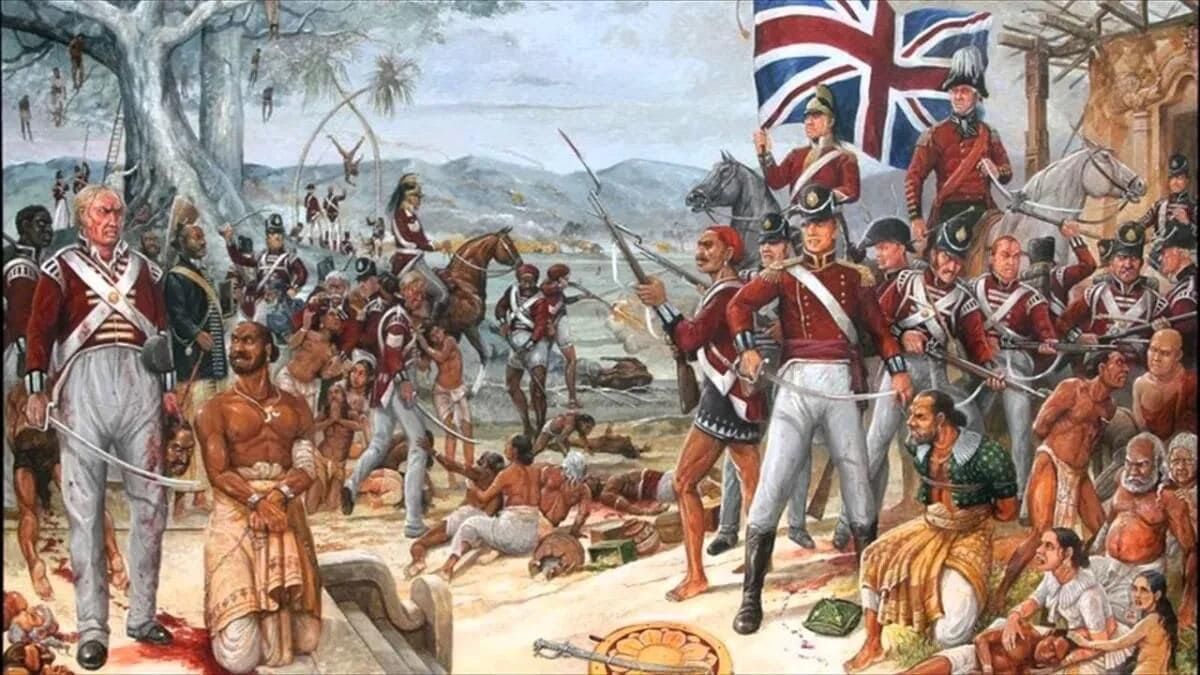
The Strategy of ‘Divide and Rule’
- The British pretended to be traders while building ties with local rulers, offering military help to some against their rivals, and becoming power brokers in Indian politics.
- They used the “divide and rule” policy, exploiting rivalries between rulers or disputes within royal families, and encouraging tensions between religious communities.
- The Battle of Plassey (1757) showed this strategy: Robert Clive conspired with Mir Jafar, the Nawab of Bengal’s commander, to betray Nawab Siraj-ud-daulah.
- At Plassey, near Kolkata, Mir Jafar’s troops stood aside, letting the smaller British force win, making Mir Jafar the new Nawab and earning him the title of “traitor” in India.
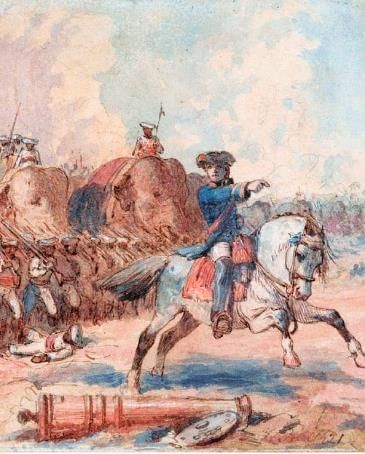 Clive leading the East India Company’s troops at Plassey
Clive leading the East India Company’s troops at Plassey
Expanding Control
- By acting as kingmakers, the British gradually controlled more land, using strategies like the Doctrine of Lapse in the 19th century.
- The Doctrine of Lapse allowed the British to annexe princely states if a ruler died without a natural male heir, ignoring Hindu adoption traditions, leading to the takeover of many states.
- This caused widespread anger, contributing to the 1857 Rebellion.
- Another tactic was the “subsidiary alliance,” where a British “Resident” was placed in Indian courts to “protect” rulers, who paid for British troops and let the British control foreign relations.
- The ruler of Hyderabad joined this alliance in 1798, followed by others, giving the British power without direct rule, creating an “empire on the cheap.”
- Once in this system, rulers couldn’t escape, as resistance faced strong British military action.
Did You Know?
In the vibrant tapestry of colonial India, princely states were dazzling realms where Indian princes, maharajas, and nawabs held sway, ruling with splendour under the umbrella of British protection.
From the grand kingdoms of Hyderabad, Mysore, Travancore, and Jammu & Kashmir to tiny yet proud territories, over 500 such states thrived at India’s Independence, covering a whopping 40% of the subcontinent. These realms pulsed with autonomy, blending royal traditions with strategic alliances, creating a mosaic of power and prestige!
From Paradise to Hell?
British policies led to devastating famines and drained India’s wealth, turning a prosperous land into one of poverty and suffering.
Devastating Famines
- After winning at Plassey, the East India Company gained revenue collection rights in Bengal, Bihar, and Odisha, some of India’s richest regions, described by Robert Clive as “the paradise of the earth.”
- The Company collected high taxes while investing little in governance or development, causing severe problems for the people.
- The Bengal Famine of 1770–1772, worsened by two years of crop failure, was caused by harsh tax demands on farmers, who had to pay cash regardless of harvest conditions, leading to about 10 million deaths, nearly one-third of Bengal’s population.
- The Company even raised land taxes during the famine, a cruelty criticised by Indian leaders and some British officials, like W.W. Hunter, who described people eating leaves and selling their children due to starvation. Key observationsfrom his account:
- Farmers were forced to sell their cattle, tools, and even seed grain to survive.
- In desperation, they sold their children, until no one was left to buy.
- People resorted to eating leaves and grass due to extreme hunger.
- Cities were overwhelmed by a constant stream of starving and diseased people - The Great Famine of 1876–1878 killed up to 8 million, mostly in the Deccan, as some Indian traders hoarded stocks for profit, and the British exported about one million tonnes of rice yearly to Britain during the famine.
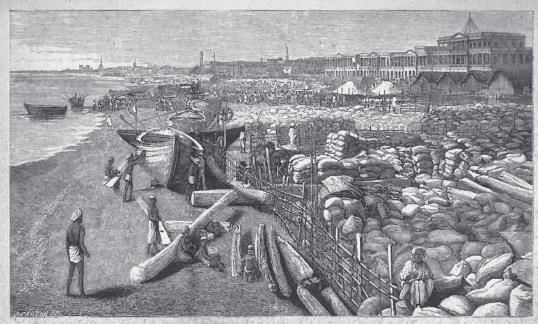 Grain bags on Madras beach, ready for export, while people were dying of hunger
Grain bags on Madras beach, ready for export, while people were dying of hunger
- The British “free market” policy, which avoided controlling food prices, worsened famines, with Viceroy Lord Lytton ordering no government interference in food prices during the 1876–1878 famine while hosting a lavish durbar in Delhi for 68,000 guests.
- Between 12 and over 20 major famines occurred during British rule, killing an estimated 50 to 100 million people, comparable to World War II deaths, along with millions of cattle and animals.
- British famine relief camps were too few and poorly supplied, with some officials, like the 1878–1880 Famine Commission, arguing against generous relief to avoid encouraging dependency.
- While famines had happened in India before, caused by droughts or wars, they were never so deadly as during British rule, pushing rural India into deep poverty.
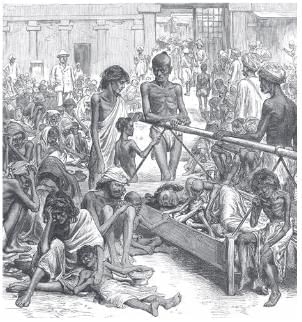 People waiting for famine relief in Bangalore
People waiting for famine relief in Bangalore
The Drain of India’s Wealth
- Economic exploitation was central to British colonial policy, with wealth from India fuelling Britain’s Industrial Revolution, as noted by U.S. historian Brooks Adams, who linked the “Bengal plunder” after Plassey to Britain’s economic growth from 1760. According to him:
- The arrival of this wealth had an immediate impact on Britain’s economy.
- He linked it directly to the start of the Industrial Revolution, dating it to around 1760.
- He described the returns from Indian plunder as unmatched in profitability, perhaps the most lucrative investment in history. - U.S. historian Will Durant called this the “stolen wealth from India,” extracted through taxes, railway and telegraph costs, and even expenses for British wars.
- Indian leader Dadabhai Naoroji, in his 1901 book Poverty and Un-British Rule in India, and historian Romesh Chunder Dutt, in his Economic History of India, estimated billions of pounds were taken from India.
- A modern estimate by Utsa Patnaik suggests Britain extracted 45 trillion U.S. dollars (in today’s value) from 1765 to 1938, about 13 times Britain’s 2023 GDP.
- If this wealth had stayed in India, the country would have been far more developed when it gained independence.
Changing Landscapes
The British reshaped India’s industries, governance, and education to serve their interests, disrupting traditional systems and creating new divisions in society.
Decline of India’s Indigenous Industries
- Before the 18th century, India was famous for its manufacturing, especially textiles like cotton, silk, wool, jute, hemp, and coir, with cotton textiles known for intricate designs, bright colours, and fine muslins in high demand worldwide.
- British policies imposed heavy taxes on Indian textiles exported to Britain while allowing British goods into India with low or no taxes, hurting Indian traders.
- Britain’s control over sea trade and exchange rates made it hard for Indian traders to export, leading to the collapse of the Indian textile industry.
- In the 19th century, India’s textile exports dropped sharply, while British imports flooded India, pushing skilled artisans into poverty and forcing them to farm on overtaxed land.
- William Bentinck, Governor-General in 1834, noted, “The bones of the cotton weavers are bleaching the plains of India.”
- Other industries like iron, steel, and paper also declined, reducing India’s share of world GDP to just 5% by Independence, turning a rich land into one of the poorest.
Dismantling Traditional Governance Structures
- Before British rule, India had well-organised local governance, with village councils managing community affairs, disputes, and public works like irrigation and roads.
- Regional kingdoms had complex administrative systems tailored to local needs, described by Charles Metcalfe in the 1830s.
- Described village communities as “little republics”, largely self-reliant and independent.
- Noted their endurance through centuries of political upheaval, including the fall of dynasties and revolutions.
- Highlighted that each village functioned like a mini-state, contributing to the survival and stability of Indian society over time. - The British replaced these with a centralised bureaucracy focused on tax collection and maintaining order, not public welfare, destroying community decision-making.
- British legal codes ignored customary laws, creating expensive, slow, and foreign-language courts that alienated Indians from the judicial system.
Transforming Indian Education
- India had diverse educational systems like pathashalas, madrasas, viharas, and apprenticeships, teaching practical skills and cultural values.
- British reports in the early 19th century noted 100,000 to 150,000 village schools in Bengal and Bihar alone, teaching reading, writing, and maths efficiently and cheaply.
- Thomas B. Macaulay’s 1835 “Minute on Indian Education” claimed European knowledge was superior, dismissing Indian literature despite his own lack of knowledge of Sanskrit or Arabic.
- Macaulay’s policy aimed to create Indians who were “Indian in blood and colour, but English in taste, opinions, morals, and intellect,” leading to the decline of traditional schools.
Creating ‘Brown Englishmen’
- The British education system created a class of English-educated Indians to serve as clerks and minor officials in the colonial administration at low cost.
- English became a prestigious language, dividing society between the elite and the masses, and disconnecting Indians from their cultural heritage.
- Despite opposition from British Orientalists who supported Indian languages, Macaulay’s policy dominated, reshaping education to serve colonial needs.
Reshaping Economic Structures to Serve Imperial Needs
- The British turned India’s self-sufficient economy, based on agriculture and crafts, into a supplier of raw materials for British industries and a market for British goods.
- The railway network, often praised as a colonial benefit, was built to move raw materials to ports for export and distribute British goods, ignoring India’s existing trade patterns.
- Railways also helped move British troops quickly to crush rebellions or fight wars, serving military needs.
- Indian tax revenue funded railways, telegraphs, colonial administration, military bases, and the lavish lifestyles of British officials, meaning Indians paid for their exploitation.
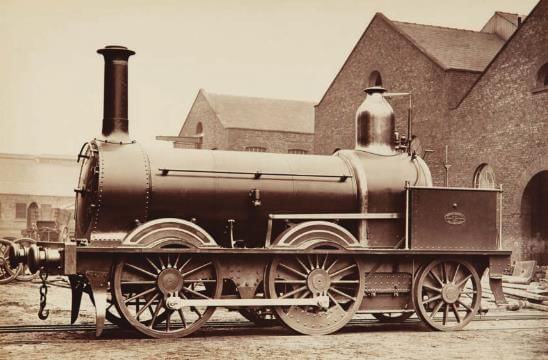 A steam locomotive of the Madras Railway
A steam locomotive of the Madras Railway
Early Resistance Movements: Challenging Colonial Authority
From the start, Indians fought against British rule through rebellions by ascetics, tribes, and peasants, showing their determination to resist foreign control.
Overview of Resistance
- The British called India “the jewel in the crown” of their empire, believing it would always remain under their control, part of an empire “on which the sun never sets.”
- From the start of British rule, Indians resisted, forming movements to push back against colonial control.
- The British Indian Empire included directly ruled areas (red and pink on maps) and princely states (yellow), connected by railways (black lines).
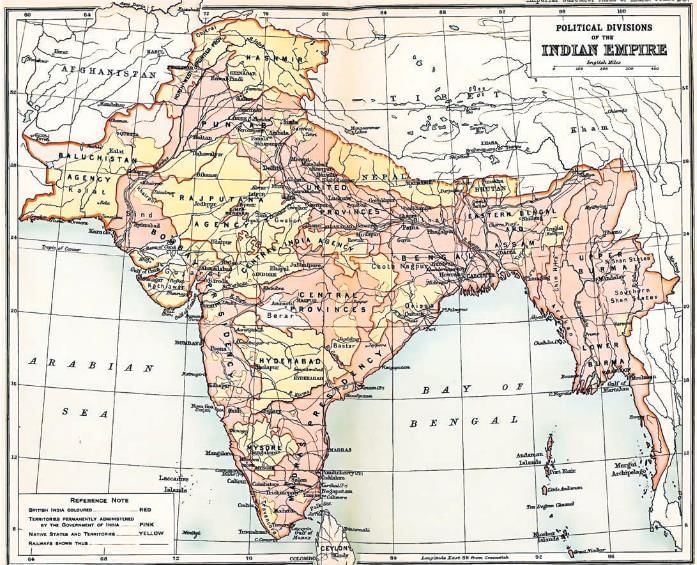 A map of the British Indian Empire in 1909
A map of the British Indian Empire in 1909
The Sanyasi-Fakir Rebellion
- The Sanyasi-Fakir Rebellion began in Bengal after the 1770 famine, caused by harsh British policies.
- Sannyasis (Hindu ascetics) and fakirs (Muslim ascetics), who travelled freely for pilgrimage and charity, faced restrictions from British land and tax policies.
- Over three decades, they attacked British treasuries and tax collectors, though their exact motives are debated.
- The British labelled them “bandits,” executed some, and used superior forces to defeat them.
- The rebellion inspired Bankim Chandra Chattopadhyay’s 1882 novel Anandamath, which included the song Vande Mataram, later India’s national song, fuelling the freedom struggle.
Tribal Uprisings
- British expansion into forests and hills disrupted tribal life, as they labelled tribals “primitive” and restricted forest access, seized land, imposed cash taxes, and encouraged missionary conversions.
- A colonial law branded many tribes as “criminal tribes,” leading to decades of harassment.
- The Kol Uprising (1831–1832) in Chota Nagpur (now Jharkhand) was sparked by land policies favouring outsiders, with Kol tribes (Mundas, Oraons, etc.) briefly controlling areas before British forces defeated them.
- The Santhal Rebellion (1855–1856) in Jharkhand, Bihar, and West Bengal, led by brothers Sidhu and Kanhu Murmu, opposed moneylenders and landlords backed by the British.
- The Santhals declared their government, vowing to fight to the end, but the British burned villages, killed thousands, including the leaders, though the rebellion inspired other tribal resistance.
Peasant Uprisings Against Economic Exploitation
- Peasants suffered from unfair British revenue systems, often losing land to moneylenders or landlords, even without famines.
- The Indigo Revolt (1859–1862) in northern Bengal saw European planters force peasants to grow indigo instead of food crops, as indigo dye was in demand in Europe.
- Peasants were poorly paid, trapped in debt, and faced torture, imprisonment, or property destruction for refusing to grow indigo.
- The uprising targeted planters, who mercenaries to attack peasants, but support from educated Bengalis and the press forced the British to curb some abuses.
- Many other uprisings occurred across India, building toward the major 1857 rebellion.
The Great Rebellion of 1857
In 1857, a massive uprising of sepoys and civilians across northern and central India challenged British rule, marking a turning point in the fight against foreign domination.
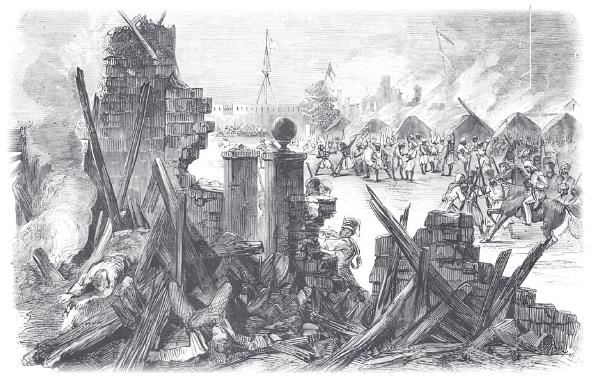 Imaginary depiction of the sepoys’ rebellion at Meerut
Imaginary depiction of the sepoys’ rebellion at Meerut
Background and Causes
- The British called it the “Sepoy Mutiny,” but post-Independence historians prefer “Great Rebellion of 1857,” as it involved more than just sepoys (Indian soldiers in the British East India Company’s army).
- Sepoys, mostly from farming families, were frustrated by British land revenue policies that caused hardship.
- Early signs of unrest included the Vellore Mutiny (1806) in Tamil Nadu, where sepoys revolted against new uniform rules banning religious marks and requiring shaved beards, offending Hindu and Muslim beliefs.
- The sepoys seized Vellore fort, killed many British officers and troops, but the British crushed the revolt, killing or executing hundreds.
- By 1857, rumours spread that rifle cartridges were greased with cow and pig fat, offending Hindu and Muslim sepoys’ religious beliefs, acting as a spark for rebellion.
The Rebellion Unfolds
- At Barrackpore (West Bengal), sepoy Mangal Pandey attacked British officers, and his execution fuelled more unrest.
- In Meerut (Uttar Pradesh), sepoys killed their British officers, marched to Delhi, and declared Mughal emperor Bahadur Shah Zafar, an elderly figurehead with little power, as their leader, though military decisions were made by commanders.
- The revolt spread across northern and central India, with sepoys capturing cities like Kanpur, Lucknow, and Jhansi.
- In Kanpur, under Nana Saheb, rebels initially promised safe passage to British civilians but massacred over 200 men, women, and children, an event still debated for its causes.
British Response
- The British response was brutal, starting with the recapture of Delhi in September 1857, where they conducted house-to-house massacres.
- In Kanpur, they held mass executions to terrorise people, and their long campaign burned villages and destroyed crops, causing countless deaths far exceeding rebel actions.
Reasons for Failure and Impact
- Historians note the rebellion failed due to the sepoys’ lack of unified command and consistent strategy, despite brave leaders.
- Though unsuccessful, the rebellion planted the idea that foreign rule was unacceptable, inspiring the 20th-century freedom struggle with new methods.
- In 1858, the British Crown took direct control from the East India Company, starting the British Raj, shifting from expansion to consolidating power.
- The Indian Army was reorganised to prevent future unified resistance.
Two Heroines of the 1857 Uprising
Rani Lakshmibai of Jhansi
- Fought valiantly to defend her kingdom from British annexation.
- Escaped a British siege of Jhansi with help from Tatia Tope, military adviser to Nana Saheb.
- Captured the Gwalior fort, along with its treasury and arsenal.
- Died in battle on 18 June 1858.
- A British officer described her as the “best and bravest of the rebels”, praising her beauty, intelligence, perseverance, and leadership.
- Tatia Tope continued the resistance until early 1859 but was betrayed and executed by the British.
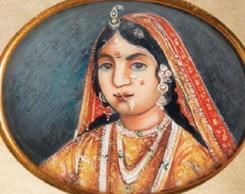 A portrait of Rani Lakshmiba
A portrait of Rani Lakshmiba
Begum Hazrat Mahal of Awadh
- Took charge after the British annexed Awadh, actively joining the 1857 rebellion.
- Led the defence of Lucknow during the British attempt to retake the city.
- Refused offers of surrender and safe passage, choosing instead to flee to Nepal.
- In response to Queen Victoria’s 1858 proclamation promising reforms and religious tolerance, she issued a counter-proclamation, warning Indians: “It is the unvarying custom of the English never to forgive a fault, be it great or small.”
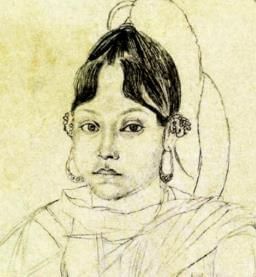 Portrait of Begum Hazrat Mahal
Portrait of Begum Hazrat Mahal
The Legacy of European Colonialism in India
British rule exploited India’s wealth and people but unintentionally opened cultural exchanges, influencing both India and the world.
Exploitation and Subjugation
- European, mainly British, rule was not a “civilising mission” but a systematic process of subjugation and exploitation, often using brutal repression.
- India’s civilisation, older than Europe’s, faced abuse, exploitation, violence, and uprooting, affecting most Indians except a small elite who accepted British rule.
Unintended Consequences
- Colonial rule opened India to the world and vice versa, with the British and French documenting India’s geography, ethnic groups, and monuments.
- British surveys mapped the subcontinent, but their ethnic lists were flawed due to unscientific ideas of “race,” now disproven by genetics.
- They studied and restored some Indian monuments, starting archaeology, but stole thousands of statues, paintings, jewels, and manuscripts, sending them to European museums or private collections.
- This theft caused a profound loss of India’s heritage but increased European appreciation of Indian art, sparking debates today about repatriating these treasures.
Cultural Exchange
- The British began translating Sanskrit texts into European languages, followed by the French and Germans, with mixed motives: some admired Indian culture, while others aimed to prove Christianity’s superiority.
- These translations, later including other Indian languages, were described by German philosopher Georg Hegel as the “discovery of a new continent.”
- Indian texts influenced European philosophers, writers, poets, artists, and even American thinkers in the 19th century, showing that cultural influence could flow opposite to political domination.
Key Points to Remember: Before We Move On
The Portuguese, Dutch, French, and British were drawn to India mainly because of its great wealth.
These European powers fought each other for control, with the British emerging dominant in the Indian subcontinent.
The British taxation policies caused widespread suffering, famines, and millions of deaths.
They also carried out deliberate deindustrialisation, destroying India’s once-flourishing manufacturing sector.
Over time, the British introduced their administrative systems, legal codes, and education system to tighten colonial control.
The Portuguese focused on religious conversion and created lasting social divisions in Goa.
The French followed a policy of assimilation, leading to a small group of culturally French Indians in Pondicherry.
From the late 18th century, many uprisings broke out, with the Great Rebellion of 1857 being the most significant, though violently suppressed.
In the 19th century, India’s classical culture, especially through translated Sanskrit texts, influenced the Western world significantly.
FAQs on The Colonial Era in India Chapter Notes - Chapter Notes For Class 8
| 1. What were the main motivations behind European colonialism in India? |  |
| 2. How did the British establish control over India? |  |
| 3. What were the significant changes in Indian society due to British colonial rule? |  |
| 4. What was the Great Rebellion of 1857, and what were its consequences? |  |
| 5. How has European colonialism left a lasting legacy in India? |  |

















